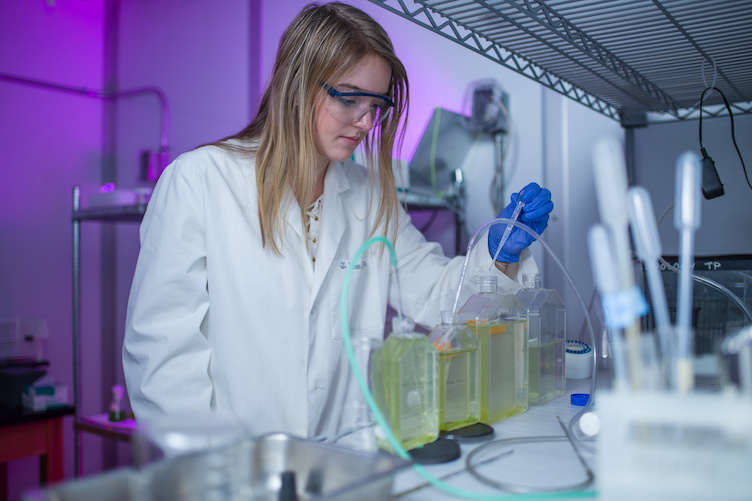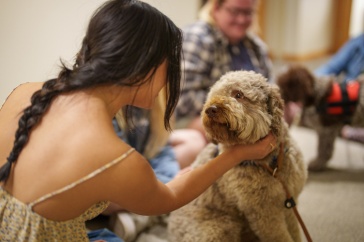
Emily Ray '20 conducting research in a UNH lab.
Emily Ray’s interest in marine sciences started when she volunteered at an aquarium near her Ohio home and fell in love with sharks. That passion was fanned through a high school science course whose college-level research component had students working in real laboratories alongside real scientists. Ray’s lab: Woods Hole Oceanographic Institute in Woods Hole, Massachusetts. Her research: the olfactory learning behavior in juvenile sharks.
“When I came to UNH, I thought I wanted to keep studying sharks,” says Ray ’20, a marine, estuarine and freshwater biology major in the College of Life Sciences and Agriculture. “Then I took a course in neurobiology and decided humans were much more interesting.”
But that realization didn’t change her course of study; it simply added to it. Ray also is majoring in neuroscience and behavior and plans to go to medical school.
For more than a year now, Ray has conducted research on cyanobacteria, commonly known as blue-green algae, under the guidance of professor James Haney. An expert on aquatic organisms and the toxins they produce, Haney cofounded the Lakes Lay Monitoring Program and is the director of the UNH Center for Freshwater Biology. His research is funded by the NH Agricultural Experiment Station. Ray learned of Haney’s work from her high school science teacher, Jessica Sakash Replogle, who graduated from UNH in 1994 with a degree in biochemistry and is head of the Science Research Institute Head at the Summit Country Day School in Cincinnati.
“Cyanobacteria has been linked to ALS. The toxins it produces are almost 10 times more toxic when they’re inhaled.”
“She’s why I’m here,” Ray says. “She’s the one who told me to check out UNH’s marine science program, which I knew nothing about. Then she gave me a copy of a UNH Magazine that had an article about professor Haney’s research, and now I work in his lab.
“We’re looking at how the bacteria is getting out of the lake and into the air,” Ray says. “Cyanobacteria has been linked to ALS. The toxins it produces are almost 10 times more toxic when they’re inhaled.”
Ray’s focus is on individual cyanotoxins, not the large algae blooms she describes as “thick, like a spinach smoothie.”
“There are so many species, and there is still so much we don’t know,” says Ray, who presented her findings at the Undergraduate Research Conference (URC) both this year and in 2017.
Recently, her interest in the toxins landed her an aquatic ecology internship with the Shoals Marine Laboratory. For 10 weeks this summer, the Cincinnati native will continue her cyanobacteria research at the Appledore Island lab, located in the Gulf of Maine.
With all the work that two majors require, Ray still makes time to volunteer. In addition to her roles as a career ambassador for the St. Martin Career Exploration Office and as a COLSA student representative for the URC committee, she also has been involved with the Make-A-Wish Foundation and the UNH dance marathon that raise money for Boston Children’s Hospital.
Additionally, Ray volunteers in the emergency room at Portsmouth Regional Hospital. “It’s a really good way to figure out if medicine is for you,” she says.
-
Written By:
Jody Record ’95 | Communications and Public Affairs | jody.record@unh.edu

















































